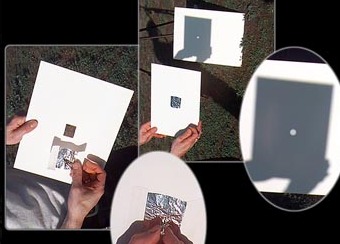Make a solar viewer
Build a simple pinhole solar viewer from cardboard, foil, and white paper to safely observe the Sun’s shape and sunspots indirectly.



Step-by-step guide to make a solar viewer
DIY solar eclipse viewer ( 5 minutes- no eclipse glasses needed)
Step 1
Ask an adult to help you make a safe solar viewer.
Step 2
Gather all the materials on a clean table so everything is ready.
Step 3
Use a pencil and ruler to mark a centered 3 cm square near the top of one side of the box.
Step 4
Carefully cut out the marked square with scissors or a craft knife while your adult helps.
Step 5
Tape a piece of aluminum foil over the hole so the foil covers the opening and is smooth.
Step 6
Use a pin to poke a tiny hole about 1 millimeter in the center of the foil.
Step 7
Tape a sheet of white paper inside the box directly opposite the foil to make a flat projection screen.
Step 8
Close or cover any other openings so the inside of the box is as dark as possible.
Step 9
Go outside with your adult helper.
Step 10
Stand with your back to the Sun.
Step 11
Point the foil side of the box toward the Sun and hold the box steady.
Step 12
Look into the open end of the box to see the Sun’s image projected on the white paper.
Step 13
Slowly tilt or move the box until the projected image looks sharp and you can spot sunspots.
Step 14
Share your finished solar viewer and what you saw on DIY.org
Final steps
You're almost there! Complete all the steps, bring your creation to life, post it, and conquer the challenge!


Help!?
What can I use if I can't find aluminum foil for covering the cut square?
If you don't have aluminum foil, use a flattened, cleaned piece of a soda can or heavy-duty kitchen foil taped over the 3 cm cut square and smooth it before poking the ~1 mm hole with the pin or a thumbtack.
Why is the Sun's image faint or blurry and how do I fix it?
If the projected image is faint or blurry, make sure the foil over the marked 3 cm square is smooth with a tiny ~1 mm pinhole, the white paper is taped flat directly opposite the foil, and all other openings are closed so the box interior is dark before you stand with your back to the Sun and re-aim the box.
How can I change the activity for younger or older kids?
For younger children, have an adult do the ruler marking, cutting of the 3 cm square, and poking of the 1 mm hole while the child tapes the foil and white paper and watches the projection, and for older kids let them measure and test different pinhole sizes or add extra foil layers to compare image sharpness.
What are some ways to extend or personalize the solar viewer after it's working?
To extend the activity, decorate the outside of the box, attach a cardboard stand to keep the box steady while you point the foil side toward the Sun, experiment with different pinhole sizes or a second box to change image size, and trace or photograph the Sun's image on the taped white paper to record sunspots for sharing on DIY.org.
Watch videos on how to make a solar viewer
How to Make a Solar Eclipse Viewer - EASY & REALLY WORKS - Build Your Pinhole Solar Eclipse Viewer!
Facts about solar observation for kids
⚫ Some sunspots are huge enough to fit the entire Earth inside them — they look dark because they’re cooler than the surrounding surface.
📷 A tiny pinhole acts like a lens and projects an upside-down image — that’s how a pinhole camera works.
🛡️ Indirect projection is safe for solar viewing — never look directly at the Sun or through unfiltered optics.
📏 Moving the screen farther from the pinhole makes a larger image, but it will get dimmer and a bit blurrier.
🌞 The Sun appears about 0.5° (half a degree) wide in our sky, so projected solar images are naturally small.
How do you make a pinhole solar viewer to observe the Sun safely?
What materials do I need to build a simple pinhole solar viewer?
What ages is this pinhole solar viewer activity suitable for?
What safety precautions should I follow when using a pinhole solar viewer?


One subscription, many ways to play and learn.
Only $6.99 after trial. No credit card required



